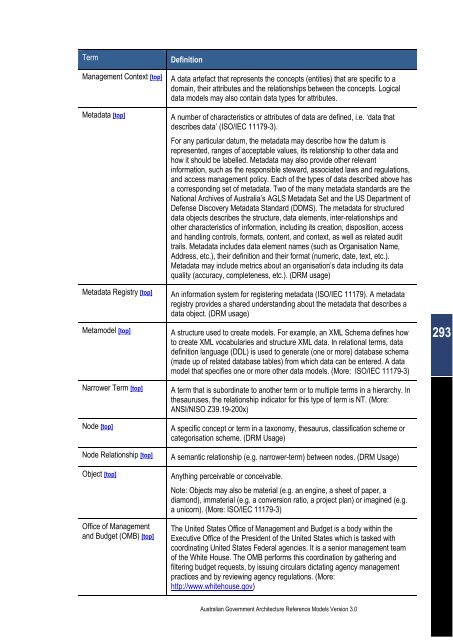Australian Government Architecture Reference Models Version 3.0
Australian Government Architecture Reference Models Version 3.0
Australian Government Architecture Reference Models Version 3.0
You also want an ePaper? Increase the reach of your titles
YUMPU automatically turns print PDFs into web optimized ePapers that Google loves.
Term Definition<br />
Management Context [top] A data artefact that represents the concepts (entities) that are specific to a<br />
domain, their attributes and the relationships between the concepts. Logical<br />
data models may also contain data types for attributes.<br />
Metadata [top] A number of characteristics or attributes of data are defined, i.e. ‘data that<br />
describes data’ (ISO/IEC 11179-3).<br />
For any particular datum, the metadata may describe how the datum is<br />
represented, ranges of acceptable values, its relationship to other data and<br />
how it should be labelled. Metadata may also provide other relevant<br />
information, such as the responsible steward, associated laws and regulations,<br />
and access management policy. Each of the types of data described above has<br />
a corresponding set of metadata. Two of the many metadata standards are the<br />
National Archives of Australia’s AGLS Metadata Set and the US Department of<br />
Defense Discovery Metadata Standard (DDMS). The metadata for structured<br />
data objects describes the structure, data elements, inter-relationships and<br />
other characteristics of information, including its creation, disposition, access<br />
and handling controls, formats, content, and context, as well as related audit<br />
trails. Metadata includes data element names (such as Organisation Name,<br />
Address, etc.), their definition and their format (numeric, date, text, etc.).<br />
Metadata may include metrics about an organisation’s data including its data<br />
quality (accuracy, completeness, etc.). (DRM usage)<br />
Metadata Registry [top] An information system for registering metadata (ISO/IEC 11179). A metadata<br />
registry provides a shared understanding about the metadata that describes a<br />
data object. (DRM usage)<br />
Metamodel [top] A structure used to create models. For example, an XML Schema defines how<br />
to create XML vocabularies and structure XML data. In relational terms, data<br />
definition language (DDL) is used to generate (one or more) database schema<br />
(made up of related database tables) from which data can be entered. A data<br />
model that specifies one or more other data models. (More: ISO/IEC 11179-3)<br />
Narrower Term [top] A term that is subordinate to another term or to multiple terms in a hierarchy. In<br />
thesauruses, the relationship indicator for this type of term is NT. (More:<br />
ANSI/NISO Z39.19-200x)<br />
Node [top] A specific concept or term in a taxonomy, thesaurus, classification scheme or<br />
categorisation scheme. (DRM Usage)<br />
Node Relationship [top] A semantic relationship (e.g. narrower-term) between nodes. (DRM Usage)<br />
Object [top] Anything perceivable or conceivable.<br />
Office of Management<br />
and Budget (OMB) [top]<br />
Note: Objects may also be material (e.g. an engine, a sheet of paper, a<br />
diamond), immaterial (e.g. a conversion ratio, a project plan) or imagined (e.g.<br />
a unicorn). (More: ISO/IEC 11179-3)<br />
The United States Office of Management and Budget is a body within the<br />
Executive Office of the President of the United States which is tasked with<br />
coordinating United States Federal agencies. It is a senior management team<br />
of the White House. The OMB performs this coordination by gathering and<br />
filtering budget requests, by issuing circulars dictating agency management<br />
practices and by reviewing agency regulations. (More:<br />
http://www.whitehouse.gov)<br />
<strong>Australian</strong> <strong>Government</strong> <strong>Architecture</strong> <strong>Reference</strong> <strong>Models</strong> <strong>Version</strong> <strong>3.0</strong><br />
293

















